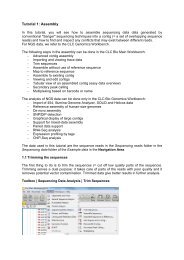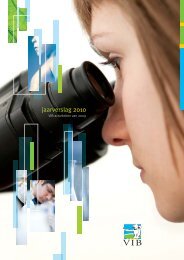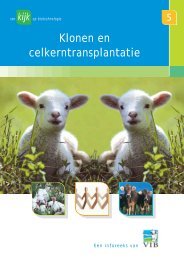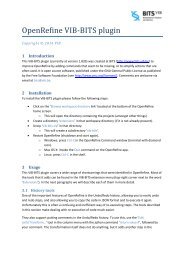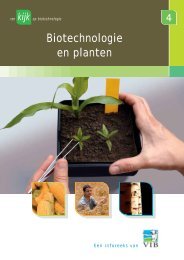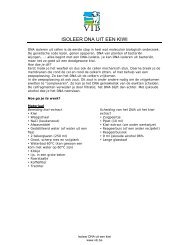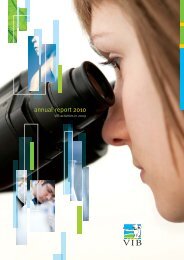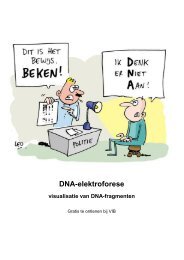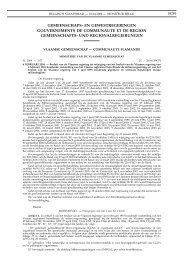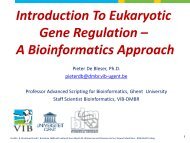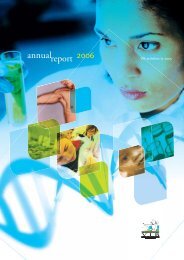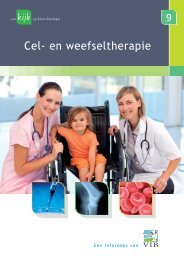Biosafety in the laboratory - VIB
Biosafety in the laboratory - VIB
Biosafety in the laboratory - VIB
You also want an ePaper? Increase the reach of your titles
YUMPU automatically turns print PDFs into web optimized ePapers that Google loves.
Animal and human cells<br />
Animal and human cells cannot spread to <strong>the</strong> environment just like that. In addition, noncontam<strong>in</strong>ated<br />
cells are unable to spread genetic material to <strong>the</strong> environment by accident.<br />
Animal and human cells cannot survive <strong>in</strong> non-sterile surround<strong>in</strong>gs. Cells that are specially<br />
designed to survive <strong>in</strong> non-sterile surround<strong>in</strong>gs, such as fish or frog eggs, are an exception<br />
to this rule. As regards non-contam<strong>in</strong>ated cells, <strong>the</strong> measures that are taken to prevent <strong>the</strong><br />
cell culture from be<strong>in</strong>g contam<strong>in</strong>ated are sufficient to prevent <strong>the</strong> cells from be<strong>in</strong>g spread<br />
to <strong>the</strong> environment. Genetic material of animal or human orig<strong>in</strong> can only be spread to <strong>the</strong><br />
environment when <strong>the</strong> cells <strong>in</strong>volved are <strong>in</strong>fected by biological agents, such as viruses, that<br />
are able to mobilize <strong>the</strong>ir genetic material. From a biosafety po<strong>in</strong>t of view, <strong>the</strong> question<br />
whe<strong>the</strong>r or not cells are <strong>in</strong>fected by biological agents is very important. Any viruses present<br />
may represent a danger to <strong>the</strong> researcher or to <strong>the</strong> environment, and any safety<br />
measures should take account of this.<br />
‘Contam<strong>in</strong>ated’ animal or human cells<br />
With regard to activities <strong>in</strong>volv<strong>in</strong>g <strong>the</strong> use of animal or human cells, a dist<strong>in</strong>ction<br />
can be made between primary cells and established cell cultures.<br />
Primary cell cultures are created by grow<strong>in</strong>g cells directly from a biopsy. It<br />
is often not possible to determ<strong>in</strong>e beforehand whe<strong>the</strong>r or not <strong>the</strong>se cells<br />
are contam<strong>in</strong>ated by an <strong>in</strong>fectious agent, such as a virus. For this reason,<br />
primary cell cultures should always be handled with care. Established cell<br />
l<strong>in</strong>es are cultures that have been grow<strong>in</strong>g for longer periods of time and<br />
which are immortalised, so that <strong>the</strong>y keep divid<strong>in</strong>g <strong>in</strong>f<strong>in</strong>itely. In most cases<br />
it is known whe<strong>the</strong>r <strong>the</strong>y are free of contam<strong>in</strong>at<strong>in</strong>g biological agents. The<br />
immortalisation of such cells may have been achieved <strong>in</strong> different ways:<br />
•spontaneously (as <strong>in</strong> NIH-3T3 cells)<br />
• as a result of a natural viral <strong>in</strong>fection (for <strong>in</strong>stance HELA cells <strong>in</strong> which a<br />
few HPV virus genes, which cause immortalisation, are present)<br />
• or by deliberate transfection of a factor that causes immortalisation.<br />
When us<strong>in</strong>g virally immortalised cells <strong>in</strong> comb<strong>in</strong>ation with vectors conta<strong>in</strong><strong>in</strong>g<br />
viral sequences, one should always check whe<strong>the</strong>r or not viral particles<br />
might be formed. If so, <strong>the</strong> cell l<strong>in</strong>e should be considered to belong to <strong>the</strong><br />
same risk class as <strong>the</strong> virus concerned.<br />
Viruses<br />
A dist<strong>in</strong>ction can be made between wild type viruses and viral vectors (constructions derived<br />
from viruses). The use of viruses or viral vectors always implies <strong>the</strong> use of host cells.<br />
Without host cells no virus can be replicated. In practice, <strong>the</strong>re are three types of activity:<br />
(1) <strong>the</strong> grow<strong>in</strong>g of cells to produce viral particles, (2) <strong>the</strong> handl<strong>in</strong>g of viral particle-conta<strong>in</strong><strong>in</strong>g<br />
supernatants (for quality controls, etc.), and (3) <strong>the</strong> transduction of a cell l<strong>in</strong>e, test<br />
animal or plant. Especially supernatants may conta<strong>in</strong> very high levels of viral particles.<br />
These supernatants should be handled carefully. Once <strong>the</strong> cell, animal or plant has been<br />
<strong>in</strong>fected, <strong>the</strong> danger depends on <strong>the</strong> virus’ or viral particle’s ability to replicate. In some<br />
The spread of organisms <strong>in</strong> <strong>the</strong> <strong>laboratory</strong> 17



